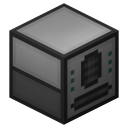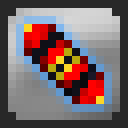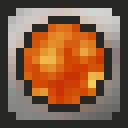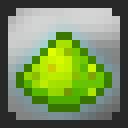Phytogenic Insolator

Definitely not organic.
A phytogenic insolator, or insolator for short, is a machine that grows and multiplies plants using water, fertilizer and simulated sunlight.
Obtaining
A placed phytogenic insolator can be instantly picked up by dismantling it with a wrench. Its configuration is preserved in the item. It can also be mined using a pickaxe, though this can be much slower.
Crafting
| Ingredients | Crafting recipe |
|---|---|
| Machine Frame + Redstone Reception Coil + Copper Gear + Dirt + Lumium Gear |
Upgrading
A phytogenic insolator is initially at the lowest tier (basic). It can be upgraded to higher tiers using upgrade kits and conversion kits.
Usage
Placement
When placed, a phytogenic insolator faces the player. It can face any of the four cardinal directions, and can be rotated using a wrench.
Processing
A phytogenic insolator has two input slots and an input tank. When combinations of items are placed in these slots and the tank is filled with water, the machine will start consuming Redstone Flux to process the items. Every item combination requires a certain amount of energy to process. When enough energy has been consumed for an item combination, the input is consumed and the output is placed in the primary output slot. A secondary output may be produced when processing certain items, which is placed in the secondary output slot.
The speed at which a phytogenic insolator processes items depends on how much energy it can use per tick. This in turn depends on how much power is being supplied, and on the machine’s maximum power usage. A basic insolator has a maximum power usage of 20 RF/t. This can be increased by upgrading the machine to a higher tier, and by installing certain augments.
Input and output
Items and fluids can enter and exit a phytogenic insolator through its sides. Every side of an insolator may correspond to one of its input slots, one of its output slots, or certain slots at the same time. Fluids can enter an insolator through any side.
A phytogenic insolator can automatically transfer items out of any sides that directly correspond to one of its output slots. This is called auto-output. It can also transfer items from adjacent inventories into any sides that directly correspond to one of its input slots. This is called auto-input. Auto-output and auto-input occur whenever the machine finishes processing an item, or every 32 ticks (1.6 seconds) if the machine is inactive.
A basic phytogenic insolator can automatically transfer up to 16 items at a time. This amount can be increased by upgrading the machine to a higher tier.
Which sides correspond to which slots/tanks and whether auto-output and auto-input are enabled can be configured using the Configuration tab in the machine’s GUI.
One of a phytogenic insolator’s input slots can be locked to only accept fertilizer items. It is locked by default.
Water can enter a phytogenic insolator through any side, regardless of configuration.
Redstone control
A phytogenic insolator may be configured to respond to redstone signals. It can be in one of three modes:
- Ignored
- Redstone control is disabled. The insolator works whenever possible. This is the default mode.
- Low
- The insolator works when not powered. When powered, it stops working.
- High
- The insolator only works when powered.
The current mode can be set using the Redstone Control tab in the machine’s GUI.
Security
A phytogenic insolator can have a signalum security lock installed to restrict who can access it.
Redprints
A phytogenic insolator’s configuration can be saved on a redprint to be copied to other insolators.
Light source
When a phytogenic insolator is active, it emits a light level of 14.
Tiers
Phytogenic insolators come in five tiers.
| Tier | Max. power usage | Augment slots | Max. items per auto-transfer |
|---|---|---|---|
| Basic | 20 RF/t | 0 | 16 |
| Hardened | 30 RF/t | 1 | 16 |
| Reinforced | 40 RF/t | 2 | 28 |
| Signalum | 50 RF/t | 3 | 44 |
| Resonant | 60 RF/t | 4 | 64 |
Augmentation
A phytogenic insolator can have augments installed to improve certain properties or to change how it works. The amount of augments that can be installed depends on the machine’s tier. A basic insolator cannot be augmented.
Augments can be installed in the Augmentation tab in an insolator’s GUI.
| Augment | Installable in | Description | |
|---|---|---|---|

|
Auxiliary Reception Coil | Any machine | Increases a machine's maximum power usage (speed). However, also increases the amount of energy required per operation. Can be installed multiple times. |

|
Auxiliary Sieve |
Machines with secondary products |
Increases the chances of a machine producing a secondary product. However, also increases the amount of energy required per operation. Can be installed multiple times. |

|
Nullification Chamber |
Machines with secondary products |
Destroys excess secondary products when a machine's secondary output slot/tank is full, allowing it to keep working. |

|
Nutrient Recovery | Phytogenic Insolator | Provides a chance for a phytogenic insolator to not consume fertilizer. However, also increases the amount of energy required per operation. Can be installed multiple times. |

|
Sapling Infuser | Phytogenic Insolator | Allows for a phytogenic insolator to grow trees. |

|
Monoculture Cycle | Phytogenic Insolator | A specialization that changes a phytogenic insolator to not consume non-fertilizer inputs. However, also increases the amount of energy required per operation, and significantly reduces the chances of producing secondary products. |
Recipes
In some of these recipes, the chance for a secondary product is higher than 100%. In this case, the secondary product is guaranteed to be produced at least once. The remainder of the chance (e.g. 25% for a 125% chance) becomes the chance of the secondary product being produced twice.
Using Phyto-Gro
Using rich Phyto-Gro
Using fluxed Phyto-Gro
Last updated: 2022-08-16 07:03:26 +0000